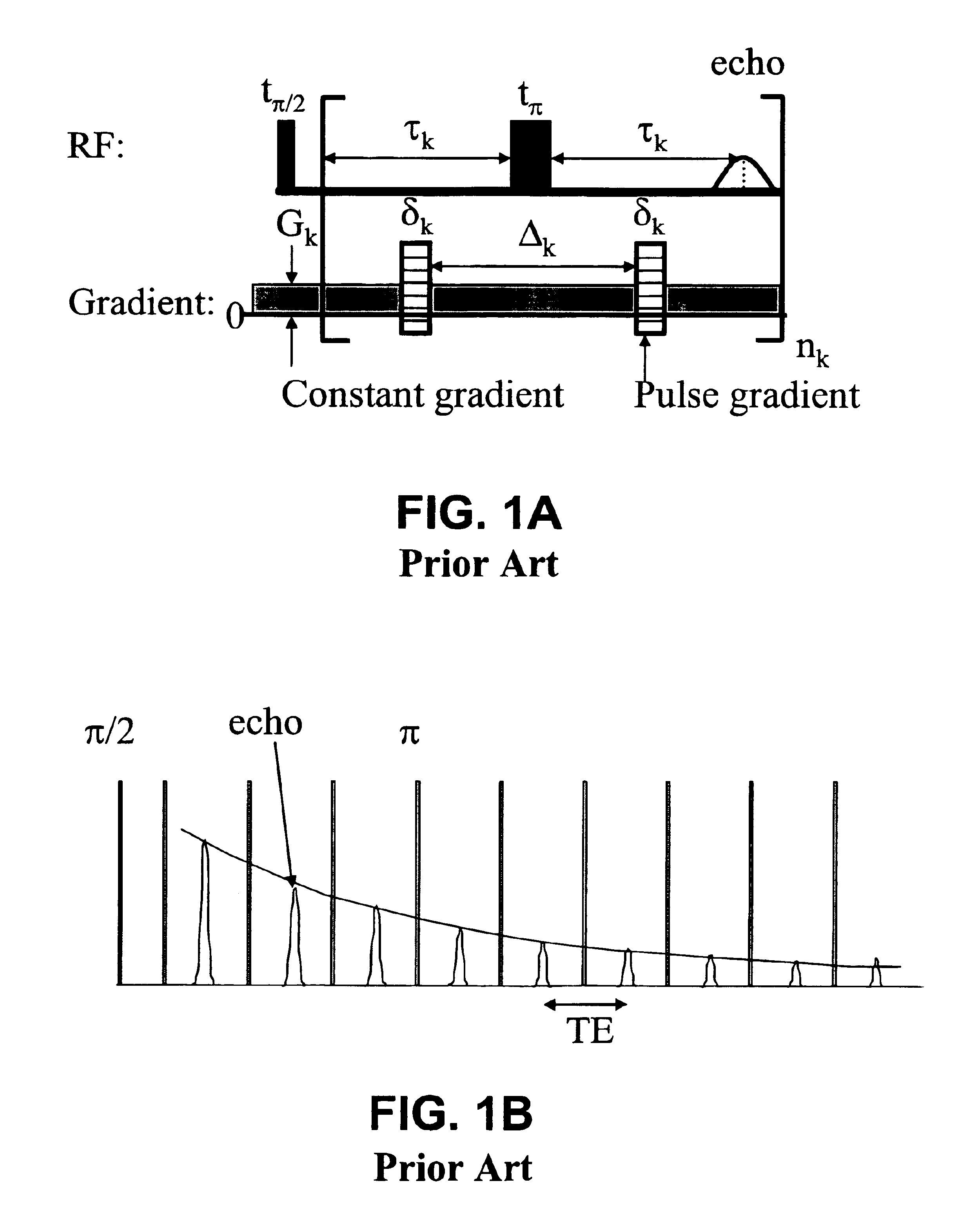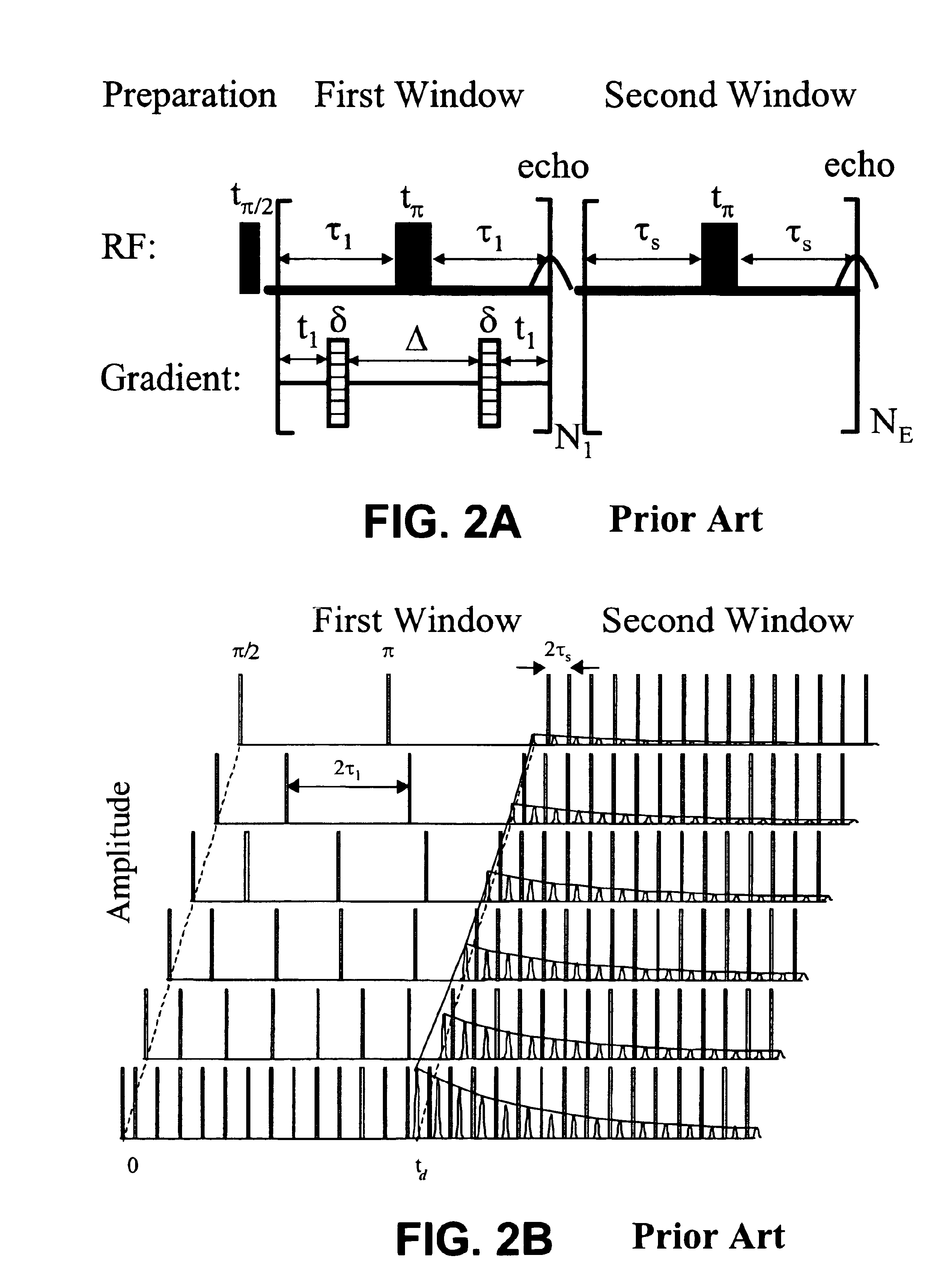Method for obtaining multi-dimensional proton density distributions from a system of nuclear spins
a nuclear spin and multi-dimensional technology, applied in the field of nuclear magnetic resonance (nmr) analysis of properties, can solve the problems of inherently difficult, difficult to distinguish proton density distributions from nmr signals, and ambiguous analysis
- Summary
- Abstract
- Description
- Claims
- Application Information
AI Technical Summary
Benefits of technology
Problems solved by technology
Method used
Image
Examples
example 1
[0073]To verify the concepts described in the above description, simulated regular CPMG echo trains have been used as input data and then the Global Inversion for Relaxation-Diffusion 2D NMR (GIRD) algorithm described above is used to obtain the Relaxation-Diffusion 2D NMR (RD2D) distribution. The GIRD result is shown in FIG. 4 which is a contour plot of RD2D distribution, showing the fluid #1 on top and fluid #2 at the bottom correctly recovering their respective value of diffusion coefficient.
[0074]In the simulation, the T2 relaxation time of a fluid #1 is set to be 1 second and of a second fluid #2 to be 100 ms. The diffusion coefficient D of fluid #1 is 2.5×10−5 cm2 / s and fluid #2 is 10−6 cm2 / s. The population of fluid #1 is 60 pu and of fluid #2 is 40 pu. The noise level is 1 pu. Fifteen TE values were used with minimum TE of 0.2 ms and maximum TE of 20 ms. Twenty relaxation components were used with T2 minimum of 3 ms and maximum of 3 s. The number of different diffusion coeff...
example 2
[0075]This example is also a simulation result: the T2 relaxation, for water is set at 300 ms and 50 ms, each with 30 pu, and for oil at 50 ms with 40 pu. A set of 10 echo trains with varying TE was generated with a Gaussian white noise of 1 p.u. The diffusion coefficients D for water and oil have the same values as used in Example 1 as is the magnetic field gradient G. Note that the recovered values for T2 and D through the GIRD algorithm are quite close to the original values. The assumed 2D map has a dimension of 25×25 with diffusion coefficient values varying from 10−7 to 10−3 cm2 / s and T2 relaxation times from 1 to 104 ms.
example 3
[0076]Example 3, shown in FIG. 6, was produced from actual NMR log data: A set of four echo trains with TE values of 0.2, 2, 4, and 6 ms were obtained. This 2D map has a range for D and T2 which is the same as that for Example 2, except a coarser grid size, 15×15, was used. Vendor's gradient field map was built in for the inversion. This 2D map shows that the right hand side peak is an oil bump and to the left is a water bump. The apparent diffusion coefficient of water is almost an order of magnitude higher than what it should be expected due to the strong internal magnetic field gradients in the pore space. The low diffusion coefficient value was not well resolved due to the lack of data for large TE. The largest TE in the simulation for Example 2 was 51.2 ms, whereas for this example the largest TE was only 6 ms.
PUM
 Login to View More
Login to View More Abstract
Description
Claims
Application Information
 Login to View More
Login to View More - R&D
- Intellectual Property
- Life Sciences
- Materials
- Tech Scout
- Unparalleled Data Quality
- Higher Quality Content
- 60% Fewer Hallucinations
Browse by: Latest US Patents, China's latest patents, Technical Efficacy Thesaurus, Application Domain, Technology Topic, Popular Technical Reports.
© 2025 PatSnap. All rights reserved.Legal|Privacy policy|Modern Slavery Act Transparency Statement|Sitemap|About US| Contact US: help@patsnap.com



